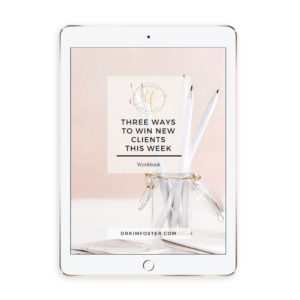
Today I’m going to dive into an old-school, local, grassroots marketing approach… and it’s a marketing strategy that, in my experience, can be incredibly powerful for getting clients into your coaching business—very quickly. Even if you’re brand new, and even if you’re just getting started.
That’s right, it’s speaking. Giving talks and workshops and presentations.
In this post and podcast episode, you’ll discover…
- why speaking is such an effective strategy for gaining new leads and clients … even for new coaches
- how to structure your talk
- how to sell from the stage (without feeling salesy)
- how to choose the perfect topic for your talk
- how to craft a compelling title for your presentation
In fact, in this post I’m going to give you an entire blueprint for how to structure your signature talks and workshops.
So let’s dive in!
By the way, if you’d prefer to listen to this topic than read it…you can do that right here:
Now, before we get into the blueprint, I want to talk to you a little bit about WHY you would want to do this.
As I tell all my clients, I’m a big fan of giving workshops or expert talks to boost your coaching business. I truly believe it’s one of the key “secret weapon” strategies that new wellness coaches (or seasoned wellness coaches!) can leverage to get clients quickly, and continue to enroll clients on a consistent basis.
Let me take a minute to outline the benefits, and why an expert talk is so effective at enrolling clients.
WHY THIS STRATEGY IS EFFECTIVE
- Accelerates the sales journey
- Increases the know-like-trust factor
- Creates true connection
- Builds your list
- Enables you to book discovery calls from every talk
- Allows you to showcase your authentic, awesome self
- Gives you an opportunity to create massive impact and provide value
Once you’ve created your signature talk, you can deliver that talk in multiple formats and locations. You can trim it down, expand it into a longer workshop…and offer it to a variety of audiences.
The truth is: giving workshops is a far better use of your time than hustling on social media, posting endless pictures on Instagram, and producing time-consuming blog posts.
You don’t need a list or a big social media following to leverage this strategy. You don’t need to have tons of experience. And you don’t need to wait before seeing results. It works fast … to quickly generate interest in your programs and bring you new clients.
Whether you’re a new health coach or you’ve been in business for a while, you can count on this strategy (if done right) to bring you new leads, clients, and group program participants.
One of my clients was struggling to get enough clients enrolled into her health coaching practice. She was a year or so into building her business. And she had been hustling and grinding it out on social media, trying to stay present on instagram and facebook, doing lots of instastories….and she was growing her list, slowly but surely, but it was taking a long time, and frustration was starting to set in.
So we reassessed, and I managed to convince her to put together a signature workshop and to start marketing it locally, and delivering it at local venues. She had a lot of information, lots of expertise and content to share…and quite frankly she was itching to get it out there, knowing that she had lots to teach and lots to share. So speaking really seemed like the perfect strategy to get some clients in more quickly, get her some cash flow and some testimonials, while building her online platform.
I helped her construct her signature, expert talk. It didn’t take long, using my framework that I’m going to teach you in this episode.
She began offering the talk to local yoga studios, at the recreation centre, an organic foods market, …places like that. And soon she started getting bookings. She began giving those talks and BOOM. Sure enough, she started booking discovery calls and enrolling clients.
The magic of being IN THE ROOM with people, your potential clients, is that it really accelerates the customer journey. That know-like-trust factor.
Which is why it’s the perfect strategy for coaches who need to get some clients through the door — like yesterday— and get this business underway, already.
So I’m hoping I’ve convinced you that this is a worthwhile marketing strategy.
Now, let’s develop your signature talk!
STEP ONE: DEFINE YOUR INTENTION
Before developing your talk, I want you to get clear on what your intention for your talk is. In other words: what is your strategic outcome? This will dictate the structure of your talk.
So, do you want to get people to register for a call with you? Sign up for your mailing list? Some other action?
STEP TWO: KNOW YOUR AUDIENCE
Once you’ve determined your outcome, the next thing to know is: who is your audience and what is your message to them?
Ask yourself: what is the problem they’re trying to solve? What is a challenge they’re struggling with…that you just so happen to have the solution for?
At this stage of building your business, you have (hopefully) done the work on discovering and defining your ideal client avatar.
However, it’s always worth going back into this work to help you choose a workshop topic.
Here are some suggestions to help you come up with a list of ideas:
Ask your email list: what do they want to learn?
Go into various Facebook or LinkedIn groups — the groups where your ideal client hangs out — and listen to the conversations there. What are their concerns? What are their struggles? What answers are people looking for?
Conduct polls, or create a survey in SurveyMonkey or Typeform.
A STRATEGIC MATCH
Your topic also needs to be related to your strategic outcome, and ideally, to your offerings. It needs to be a match, to be a logical connection.
As an example, if your programs are about helping new moms with stress, talking about children’s nutrition won’t be your best choice. There’s an overlap of audience, certainly, and some of the moms who will come to a talk about their kids’ nutrition may be stressed, sure, but if they’re there to listen to the information you have on their child’s diet, it won’t be a natural next step to sign up to learn more about your stress management program.
If your programs are about stress management for new moms, give a talk that pulls out one piece of that puzzle, and provides value on that topic.
THE LAYERS OF CHALLENGE OR OBSTACLE
When generating topic ideas, it may help you to consider the various layers people struggle with, even within a particular problem. Here’s what I mean:
For any given problem, there can be:
- The “known” struggle (ie. the things people are aware of and talk about)
- The “consciously concealed” struggle (ie. the things people are aware of, but they hide and don’t talk about)
- The “unconscious” struggle (ie. the problem they aren’t aware they have)
Here’s an example to illustrate:
Your audience’s known struggle: they want to lose weight.
Their consciously concealed struggle: the guilt, the shame, the self-hatred.
Their unconscious struggle: they’ve been focusing on the wrong things (what to eat) when what they need to focus on is HOW to eat, and how to stop the self-sabotage brought on by their guilt and shame.
A very strong presentation could be constructed that addresses all three layers of this struggle. You could begin with the problem they know and talk about, then address the problem they know they have but that they hide, and then educate them on the problem they don’t know they have — and what to do about it.
STEP THREE: CHOOSING A KILLER TITLE FOR YOUR TALK
Let’s face it, a fabulous title can make or break your workshop.
Below are a few different ways you could create your title. Use these templates to inspire or get your juices flowing:
Template #1:
Start with a big concept, and then address any objections: how to X (benefit/outcome) without Y.
Example: How To Go Gluten-Free: The easiest and most pleasurable way to remove gluten from your diet … even if you love bread and can’t imagine giving up pizza.
Template #2:
Start with a desired result (as the title), then add a subtitle: x number of ways to do it (positive, positive, positive), then one thing that’s negative or contrast or funny.
Example: The Sleep Solution: 7 steps to get more sleep, wake up refreshed, and have more energy every day (no matter how exhausted you are right now).
Template #3:
This title style makes good use of contrast. Basically, you contrast something negative with something positive.
Example: From Hot Mess to Calm Success: Stress Management Strategies for Busy Women Executives
Template #4:
Start with something unusual (which serves as a pattern interrupt), then add a subtitle: X surprising ways to do something.
Example: The Gut Game: 5 Secret Reasons Your Health Resides In Your Gut
My recommendation is that once you’ve generated 3 or 4 titles you like, create a Facebook poll and ask for opinions!
A caveat, however: only put this out to groups where the people really get you, and they have some kind of frame of reference for this kind of thing ie. health coaching or entrepreneurial ventures.
As a general rule, always try to seek out quality input and feedback.
STEP FOUR: CREATING YOUR TALK
Once you’ve chosen your topic and created a great title, you need to create a basic framework, or structure, for your talk. Use the tool of your choice to organize your talk outline, but I suggest Evernote, a Word document, or Google Docs to get started.
It’s critical to have a great structure for your talk, in order to create that desire to take action, and to help build that know, like, and trust factor with your audience. Here is an effective outline for a talk or workshop:
OPENING
Open your presentation with a HOOK: a powerful statement, question, or quote. This grabs attention and makes them want to know more. One trick: if you’re starting by asking a question, have the answer be yes. This puts people in a positive frame of mind, and gets them to start imagining a new possibility. You’re tapping into the part of the brain that gets them feeling excited, creative, and ready to learn new things.
From there, move into the PROMISE. This is what they can expect from the rest of their presentation. You’re establishing the importance of the presentation (the WHY) and you’re generating excitement and anticipation for what’s to come. This is also effective because you’re creating a subconscious bond with the audience. Most people won’t want to leave until you’ve fulfilled your promise to them. You’re forming a pact with them, and drawing them in.
Next, establish the PROBLEM. This is where you can talk about the three layers of struggle (the known problem, the consciously concealed problem, and the unconscious problem) — or at least the first two issues (the unconscious problem is one you can dive into at a later stage in your talk). This is where you demonstrate your understanding of the issues, empathize with the struggle, and talk about the frustrations in a way the audience will resonate with.
Finally, you tease the PLAN. This is where you give an overview of the solution that you’re going to be offering during the presentation. Don’t go into detail yet — that will come in a bit. Simply introduce your signature system, or briefly describe your core message. For example: “In a moment I’m going to walk you through the seven steps….”. You’re giving a brief overview or agenda, and describing what the audience will learn.
All told, your opening should take anywhere from 2-5 minutes (or possibly longer, if this is a longer-format workshop).
YOU & YOUR STORY
After your opening, you’re going to introduce yourself, and share some details of your story. This is not you sharing your entire life story! You’re going to choose a strategic part of your story, as it relates to this topic. You’ll describe your struggle, challenge, or conflict. You’ll share a story that explains why you became an expert in this subject, and why the audience should listen to you.
This is an opportunity to create an emotional connection with the people in the room. It’s also a great place to begin to address the problem they know they have, but that they don’t admit publicly yet. But through your story, you can share that you’ve struggled with that issue.
In this section, you also want to establish your credibility, and highlight your expert status in this topic or field.
Be careful of making this part too long. Keep it short and sweet! In a 60-90 minute presentation, 5-10 minutes is plenty.
CONTENT
Your content will fill the bulk of your presentation. It’s a good idea to structure your content into chunks: give 3-5 tips or strategies. It’s also a good idea to showcase client stories or case studies throughout this part. An effective strategy is also to give rookie mistakes, or bust common myths about your topic. This is your opportunity to demonstrate your authority. You’re providing value for your audience, and giving them concrete strategies and ideas, but you’re also seeding your presentation with testimonials, setting yourself up for your eventual call-to-action.
If you have a longer time frame to work with, consider doing exercises with your audience, or including some workshop-style back-and-forth, rather than jamming the time full of more information. The truth is, when people participate and engage with content, their retention improves, and they get more value. If you can get people to actively engage in some way with the content (versus just passively listening to it), they will have a greater transformation.
YOUR OFFER
At this stage, you’re ready to make your call-to-action. This is a critical part of your presentation. Don’t make the rookie mistake of not telling your audience exactly what you want to do next.
If you’re feeling uncomfortable with being “salesy”, then try to think (and structure) this as just another tip or piece of value.
Introduce the problem they have now, then introduce the solution (your offer).
Now, this offer, or call-to-action, can be a very brief mention of your availability to jump on a phone call for a discovery session (with specific instructions for how to do that), or it can be a detailed outline of your program. Choose the format that makes the most sense for you and your business, and is also appropriate for the presentation topic and venue.
An alternative placement of your offer or call-to-action is midway through your content section. Again, it could be framed as just another tip or strategy.
Q&A SESSION
Depending on the schedule and the venue, plan to spend 10-15 minutes here. Don’t be tempted to skip your Q&A session! This is often a very effective section for converting audience members to taking things to the next step with you, because they see you as an expert.
WRAP-UP
This is when you spend 1-2 minutes to wrap things up, thank the audience for staying with you, and briefly summarize “what they learned”. You can even have a summary slide with a list of your tips, if that works for you. Leave by offering one last reminder of your call-to-action, and then you’re all done!
And there you have it! Now that you’ve got the whole framework for your signature workshop, it’s time to get started creating it!
Resources:
3 Ways To Win New Clients This Week

Ready to plan your next steps in your wellness business? LET’S HOP ON A CONSULTATION CALL! LEARN MORE HERE
Subscribe Links:





